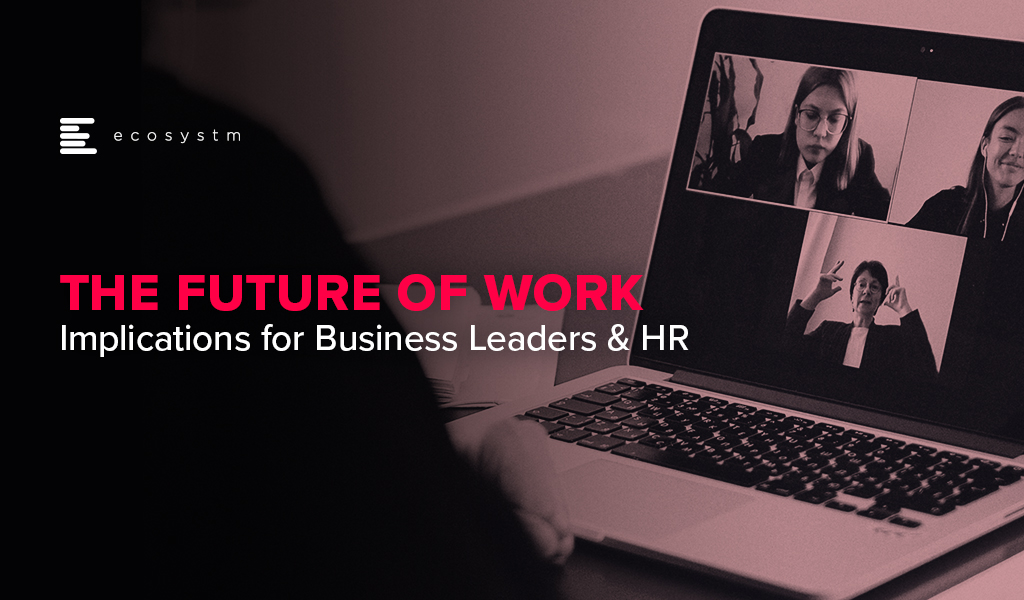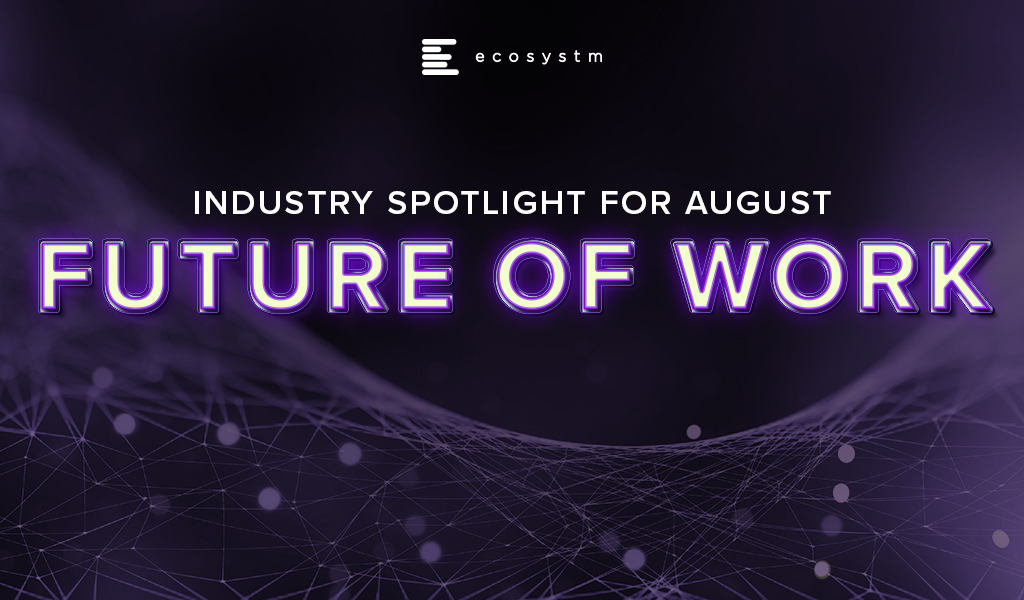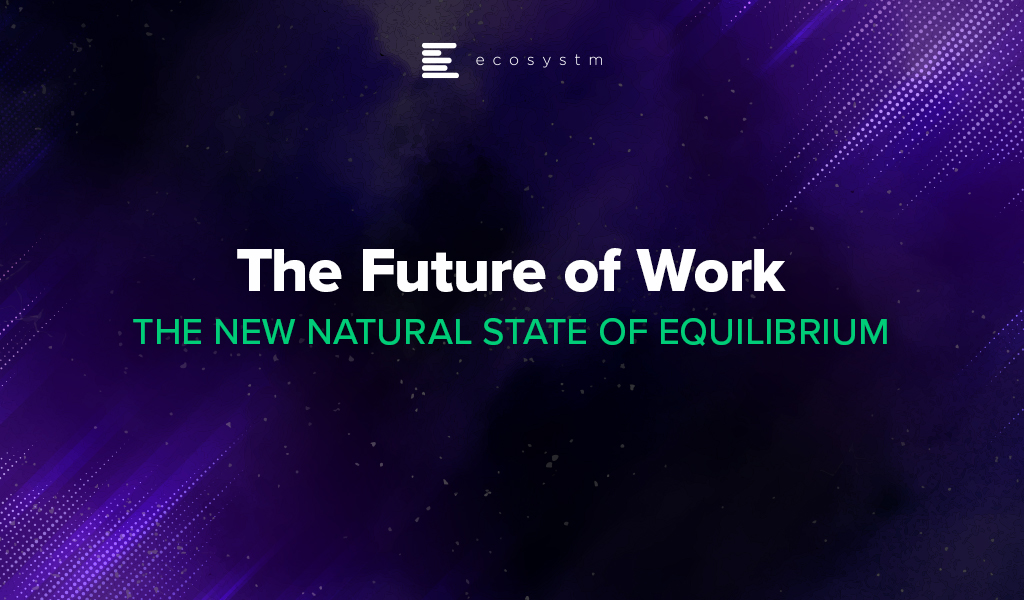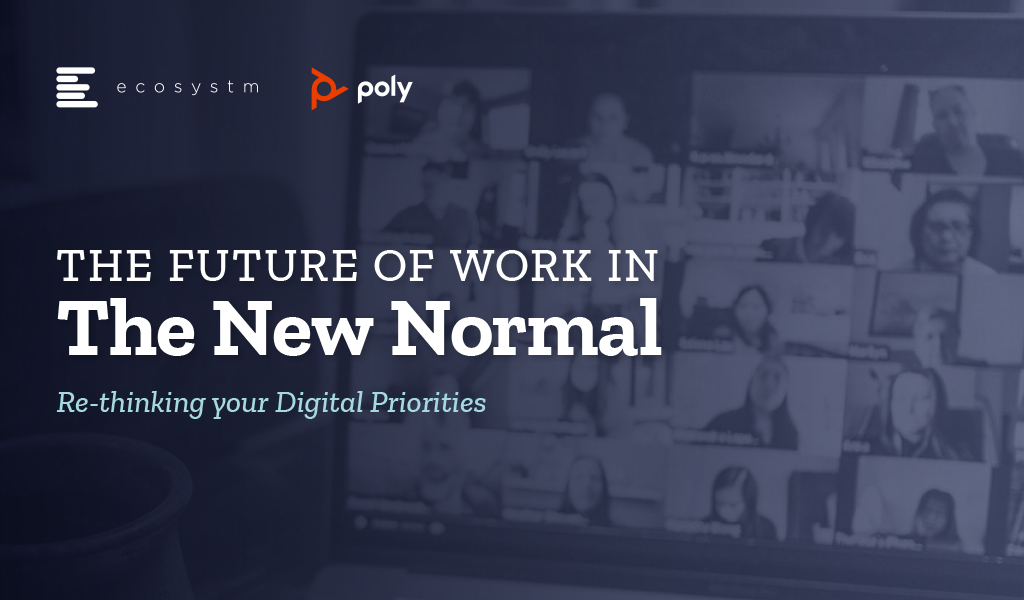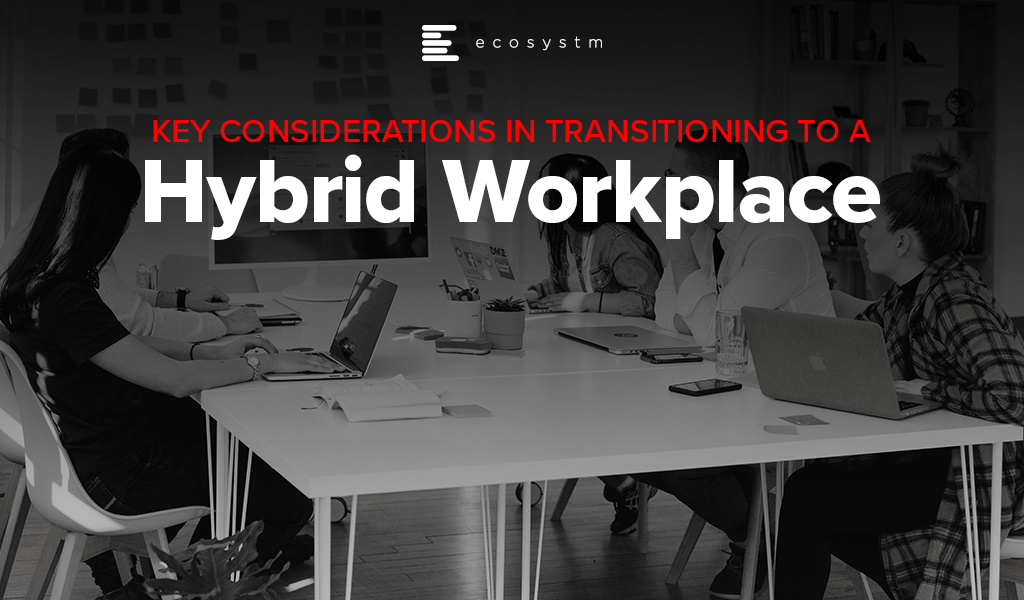The COVID-19 crisis has required major resets in how organisations function – across industries and economies. In this environment of intense changes, businesses that have been agile in their operations and were better digitally enabled have thrived, while others have struggled. Irrespective of whether an organisation has been able to pivot fast to thrive or struggled to cope, it is very clear that the Future of Work is here now. Every organisation has had to make some changes to their People and work practices. It is time to (re) focus on employee experience holistically so that organisations can be ready for whatever model of work becomes prevalent in the future. I have recently published a report offering guidance to business leaders and HR Teams on how to make holistic workplace shifts, with inputs from Ecosystm Principal Advisors, Tim Sheedy and Audrey William.
Employee Experience at the Core of Customer Strategies
It has become increasingly clear that customer experience (CX) is not just about good sales skills or customer service. It is about the overall experience of the customer from start to post-purchase. Customers are focused on not just what they are buying but also on how they are treated along their entire journey. Good CX has consistently shown to help increase price premium, impulse buying, and loyalty. Consequently, one bad experience can drive a customer away forever. Customers pay for your products or services, but it is your people who can really deliver the experience.
Audrey says, “As it becomes clear that we are headed for a hybrid/blended model of work, employee experience (EX) has to be a key focus area for organisations. Organisations will have to support remote work and simultaneously evolve their physical workplaces so that employees have the choice to come into work. But business leaders and HR will definitely have to come together to re-evaluate their policies around employees and improving EX – irrespective of where they choose to work from.”
The Role of Productivity in the Digital Workplace
Productivity has been at the core of an organisation’s desire to be a digital workplace. Tim says, “A digital workplace is one that has the capability to support any employee to access the process, information or system they need on their device of choice, in their moment and location of need. In the wake of the pandemic, the digital workplace went from being a ‘good idea’ to an ‘absolute necessity’ – and the seeds were sown to build true digital workplaces, years ahead of plan.”
This is the time to retain that focus on productivity. A lot of energy is being spent in defining and measuring productivity. The focus seems to have shifted to how to get the best out of the remote/hybrid workforce. It is time for business leaders and HR to go back to the drawing board to re-define what productivity means to their organisations.
Tim says, “The focus should be on enabling productivity rather than on monitoring activity. Productivity is an outcome, not a process. So, measure the outcome, improve the process. Productivity will be driven at an organisational level through removing friction from overall operational processes, to make things more streamlined and effective to create more value.”
The True Implication of Flexibility
There has been a rapid shift in practices around working from home and flexibility. But it is time now for organisations to create a framework (policy, performance expectation and management) to manage these practices. Many companies do not really understand the implications of flexible working to their business. In fact, they may be unaware of shifts in work patterns that have taken place in the last few months and the impact these shifts are having on the business.
Framework around flexible working should be backed by data and an understanding of the feasibility of such practices. If your employee has to work on her compulsory day off, then you do not have a truly flexible work practice. This will have a negative impact on employee experience and ultimately on your business.
The Evolution of Employee Engagement
Audrey says, “One of the areas that business leaders and HR will have to bear in mind is that despite flexible working hours, employees might be overworked – it is emerging as a common problem with working from home. It is common that many employees are working longer hours.”
Ecosystm research finds that some organisations have been evolving their HR practices, since the start of this crisis (Figure 1).

But more needs to be done. Organisations have to work really hard to replicate their employee engagement and social hours in the virtual world. It is critical that organisations design mechanisms of keeping employees connected – to each other, as well as to the organisation. “Virtual social groups” not only provide this connection, it can also be a rich source of input for HR and wellness teams to quickly adapt their programs to meet the changing needs of employees.
Shift in Managerial Styles
Performance management has been traditionally done through annual cycles, and by monitoring and tracking. In the Future of Work, organisations will have to increasingly give their employees the choice of working from home. Meetings, check-ins, 1:1 and team huddles for close monitoring will not work in this remote/hybrid model.
It is time to stop close monitoring and really focus on outcome-based management. And this will have to start with re-skilling people managers. Training should be provided on softer skills such as emotional intelligence, being able to sense across boundaries and digital spaces, and being able to be responsive to employees’ needs. The people manager must evolve into being a coach and a mentor – internal coaching and mentoring networks will have to be established. Line managers, business leaders and HR teams will need to collaborate more to ensure that these skills are developed and that the right support system is in place.

The Future of Work is here, now. Organisations were faced with unprecedented challenges of coping with the work-from-home model, when COVID-19 hit earlier this year. Many organisations managed the pivot very successfully, but all organisations were impacted in some way. Various trends have emerged over the last few months, that are likely to persist long after the immediate COVID-19 measures are removed by countries. In the Ecosystm Digital Priorities in the New Normal study, we find that organisations will continue to cater for remote employees (Figure 1) and keep a firm eye on employee experience (EX).
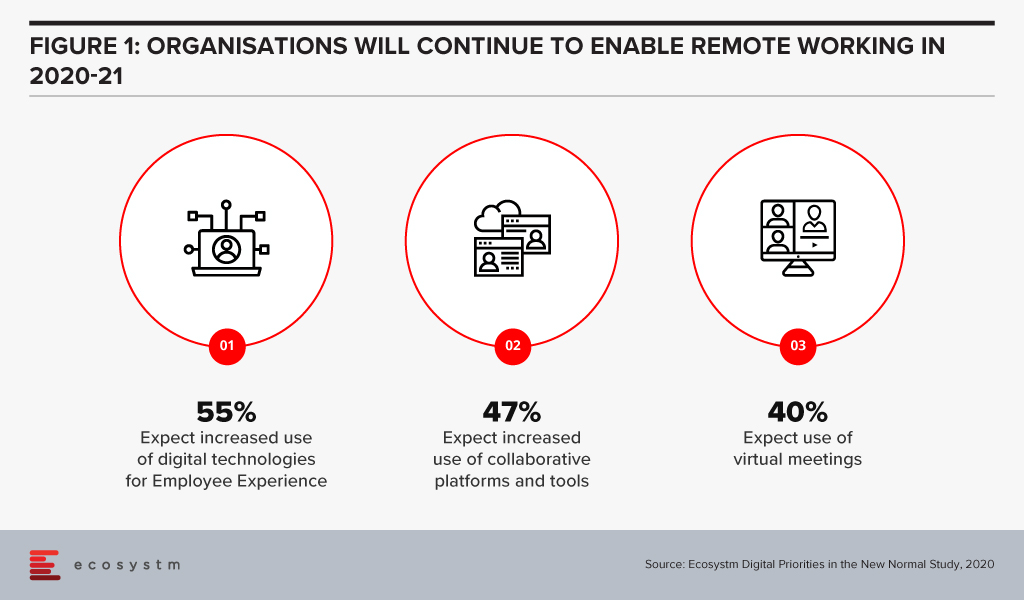
August has seen these clear trends in the Future of Work
#1 Tech companies leading from the front in embracing the Future of Work
As the pandemic continued to spread across the globe, various companies adopted the work from home model at a scale never seen before. While it is still unclear how the work model will look like, many companies continue to extend their remote working policies for the remaining year, and some are even thinking of making it a permanent move.
Tech companies appear to be the most proactive in extending remote working. Google, Microsoft, and AWS have all extended their work from home model till the end of the year or till the middle of next year. Earlier in the month Facebook extended its work from home program until mid-2021 and are also giving employees USD 1,000 to equip their home offices. This appears to be a long-term policy, with the company announcing in May that in the next 5-10 years, they expect 50% of their employees to be remote. Similarly, Salesforce and Uber also announced that they would be extending remote working till the mid-next year, and are providing funding for employees to set up the right work environment.
In Australia, Atlassian has made work from home a permanent option for their employees. They will continue to operate their physical offices but have given employees the option to choose where they want to work from.
Some organisations have gone beyond announcing these measures. Slack has talked about how they are evolving their corporate culture. For example, they have evolved their hiring policies and most new roles are open to remote candidates. Going forward, they are evaluating a more asynchronous work environment where employees can work the hours that make sense for them. In their communique, they are open about the fluid nature of the work environment and the challenges that employees and organisations might face as their shift their work models.
Organisations will have to evaluate multiple factors before coming up with the right model that suits their corporate culture and nature of work, but it appears that tech companies are showing the industry how it can be done.
#2 Tech companies evolve their capabilities to enable the Future of Work
Right from the start of the crisis, we have seen organisations make technology-led pivots. Technology providers are responding – and fast – to the changing environment and are evolving their capabilities to help their customers embrace the digital Future of Work.
Many of these responses have included strengthening their ecosystems and collaborating with other technology providers. Wipro and Intel announced a collaboration between Wipro’s LIVE Workspace digital workspace solution and the Intel vPro platform to enable remote IT support and solution. The solution provides enhanced protection and security against firmware-level attacks. Slack and Atlassian strengthened their alliance with app integrations and an account ‘passport’ in a joint go-to-market move, to reduce the time spent logging into separate services and products. This will enable both vendors to focus on their strengths in remote working tools and provide seamless services to their customers.
Tech companies have also announced product enhancements and new capabilities. CBTS has evolved their cloud-based unified communications, collaboration and networking solutions, with an AI-powered Secure Remote Collaboration solution, powered by Cisco Webex. With seamless integration of Cisco Webex software, Cisco Security software, and endpoints that combine high-definition cameras, microphones, and speakers, with automatic noise reduction, the solution now offers features such real-time transcription, closed captioning, and recording for post-meeting transcripts.
Communication and Collaboration tools have been in the limelight since the start of the crisis with providers such as Zoom, Microsoft Teams and Slack introducing new features throughout. In August Microsoft enhanced the capabilities of Teams and introduced a range of new features to the Teams Business Communications System. It now offers the option to host calls of up to 20,000 participants with a limit to 1,000 for interactive meetings, after which the call automatically shifts to a “view only” mode. With the possibility of remote working becoming a reality even after the crisis is over, Microsoft is looking to make Teams relevant for a range of meeting needs – from one-on-one meetings up to large events and conferences. In the near future, the solution will also allow organisations to add corporate branding, starting with branded meeting lobbies, followed by branded meeting experiences.
While many of these solutions are aimed at large enterprises, tech providers are also aware that they are now receiving a lot of business from small and medium enterprises (SMEs), struggling to make changes to their technology environment with limited resources. Juniper has expanded their WiFi 6 access points to include 4 new access points aimed at outdoor environments, SMEs, retail sites, K-12 schools, medical clinics and even the individual remote worker. While WiFi 6 is designed for high-density public or private environments, it is also designed for IoT deployments and in workplaces that use videoconferencing and other applications that require high bandwidth.
#3 The Future of Work is driving up hardware sales
Ecosystm research shows that at the start of the crisis, 76% of organisations increased investments in hardware – including PCs, devices, headsets, and conferencing units – and 67% of organisations expect their hardware spending to go up in 2020-21. Remote working remains a reality across enterprises. Despite the huge increase in demand, it became difficult for hardware providers to fulfil orders initially, with a disrupted supply chain, store closures and a rapid shift to eCommerce channels. This quarter has seen a steady rise in hardware sales, as providers overcome some of their initial challenges.
Apart from enterprise sales, there has been a surge in the consumer demand for PCs and devices. While remote working is a key contributor, online education and entertainment are mostly prompting homebound people to invest more in hardware. Even accessories such as joysticks are in short supply – a trend that seems to have been accelerated by the Microsoft Flight Simulator launch earlier this month.
The demand for both iPad and Mac saw double-digit growth in this quarter. Around half of the customers purchasing these devices were new to the product. Apple sees the rise in demand from remote workers and students. Lenovo reported a 31% increase in Q1 net profits with demand surges in China, Europe, the Middle East and Africa.
#4 The impact on Real Estate is beginning to show
The demand for prime real estate has been hit by remote working and organisations not renewing leases or downsizing – both because most employees are working remotely and because of operational cost optimisation during the crisis. This is going to have a longer-term impact on the market, as organisations re-evaluate their need for physical office space. Some organisations will reduce office space, and many will re-design their offices to cater to virtual interactions (Figure 1). While now, Ecosystm research shows that only 16% of enterprises are expecting a reduction of commercial space, this might well change over the months to come. Organisations might even feel the need to have multiple offices in suburbs to make it convenient for their hybrid workers to commute to work on the days they have to. Amazon is offering employees additional choices for smaller offices outside the city of Seattle.
But the Future of Work and the rise of a distributed workforce is beginning to show an initial impact on the real estate industry. Last week saw Pinterest cancel a large office lease at a building to be constructed near its headquarters in San Francisco. The company felt that it might not be the right time to go ahead with the deal, as they are re-evaluating where employees would like to work from in the future. Even the termination fees of USD 89.5 million did not discourage them. They will continue to maintain their existing work premises but do not see feel that it is the right time to make additional real estate investments, as they re-evaluate where employees would like to work from in the future.
There is a need for organisations to prepare themselves for the Future of Work – now! Ecosystm has launched a new 360o Future of Work practice, leveraging real-time market data from our platform combined with insights from our industry practitioners and experienced analysts, to guide organisations as they shift and define their new workplace strategies.

As the saying goes, the “Future Ain’t What it Used to Be”. This has certainly been true of 2020. There have been many aspects of business that have rocked the foundation of what “used to be”, i.e. technology, changing business models, and digital transformation – all amid the onslaught of the coronavirus. All of these have affected every industry and every business, quite literally around the world.
Some businesses and individuals are beginning to effectively address and deal with this continuously evolving landscape. Others are unsure how to proceed. And still others are freezing like a deer in the headlights of an oncoming vehicle. While no one can predict the future with certainty, it is still possible to assess their rapidly changing environment and develop business scenarios to consider the various potential outcomes.
COVID-19 has impacted all businesses, industries, and individuals. It has impacted how both business and work is conducted. Even after the crisis has passed, new ways of doing both will be required. The businesses which are thriving right now understand these changing requirements and how they might impact their Future of Work. They have learned what is required for them to compete through a New Holistic approach in order to be agile and adapt to sudden changes and a very competitive global marketplace.
At Ecosystm, we have developed a new 360o Future of Work practice, based on the changing business environment and what companies need to adapt, pivot and thrive. The 360o Future of Work practice is comprised of four components:
- The Business (organisation)
- The People (employees)
- The Technology (tools)
- The Work Environment (where work is done)
The Business component is of course the driver. The People component is key – they are one of the most important assets to make the Business successful. They are the Talent. The Work Environment and Technology are critical enablers. As enablers they allow the People to be more collaborative, innovative, creative, and effective, to contribute to the Business’s success.
When all four components work in unison, the outcome is an effective Business designed to meet future challenges, competitors, and the unknown black swans – we call this organisation the “Empowered Business” (Figure 1). It is essential that each of these four components be understood and discussed and organisations seek advice in detail with respect to the specific business strategy in order for the Company to not only succeed, but thrive in the New Natural State of Equilibrium.

What to Expect
In subsequent articles, the 360o Future of Work practice leaders (Ravi Bhogaraju – People & Organisation; Tim Sheedy – Technology; and I – Work Environment) will discuss each of these components in detail and provide some insight as to how best to prepare for the new Natural State of Equilibrium, a post COVID-19 world.
For more information about the 360o Future of Work practice Or to speak to one of our experts, contact us on info@ecosystm360.com
I recently came across an article which makes 7 predictions for a post COVID world. Upon reflection, I agree with the predictions to varying degrees and decided to comment further.
First, let me share a couple of general observations. Currently, we are still in the eye of the storm. Many are unable to see any light at the end of the tunnel. There is quite a bit of negative sentiments, and some fail to see that the situation will ever improve. I am sure similar thoughts occurred during other crises: the 1918 Pandemic (Spanish Flu); the Great Depression of the 1930s; the Dot.com bust of 2001; SARS in 2003; and the Global Financial Crisis/Great US Recession of 2007. During each of these events, a sense of impending Armageddon came over much of the population. Certainly, in each instance, people did experience some personal and social permanent changes, with which they learned to adapt and cope. But, inevitably, the world did go on and Armageddon did not occur.
One of the basic truths I believe, is that humans require and crave interaction with other humans. Think about the videoconferencing applications. The use of these apps grew exponentially as the main communication channel. Instead of just audio, it was audio and video. These mediums greatly assisted society in coping and adapting. Mankind, and the Natural World, will always find a way.
Here are the predictions from the article:
- Companies that traffic in digital services and e-commerce will make immediate and lasting gains
- Remote work will become the default
- Many jobs will be automated, and the rest will be made remote-capable
- Telemedicine will become the new normal, signaling an explosion in med-tech innovation
- The nationwide student debt crisis will finally abate as higher education begins to move online
- Goods and people will move less often and less freely across national and regional borders
- After an initial wave of isolationism, multilateral cooperation may flourish
I very much agree with the author’s first prediction. This one is fairly obvious, as it has proven true throughout the crisis with providers such as Amazon, Zoom and others. It is expected to continue into the post COVID world. This is also evident from the findings of the Ecosystm research on the impacts of COVID-19. Organisations intend to continue to use digital technologies, even after the immediate crisis is over (Figure 1).
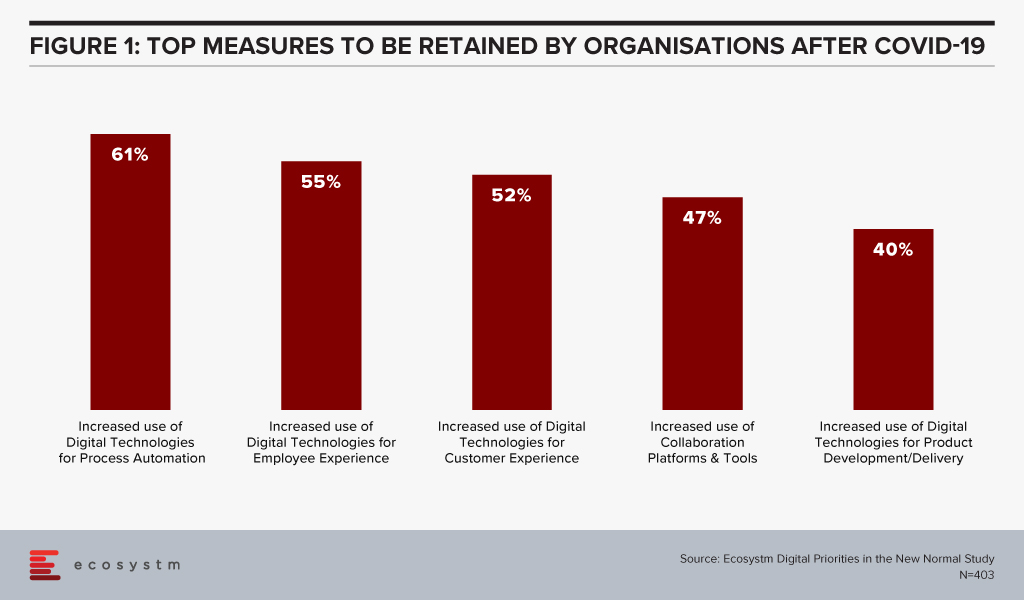
A Natural State of Equilibrium will Emerge
I believe for each of the areas described in the predictions, there will be various levels of long-term modification. None of them will return to their pre COVID-19 state, as we have all experienced going down the rabbit hole. During the pandemic, due largely to the lockdowns, the pendulum swung significantly towards one side. Many times, when people predict a new view, the current state is considered the New Normal. For me, the relevant question is: Will things stay as they are now, or will there be a new natural state of equilibrium? If so, what will it look like, in each of these areas? I don’t believe there is one answer, or one New Normal for all the dimensions being discussed. I believe a new normal state will potentially be different for each individual, each company/entity and each condition. In a post COVID-19 world there could be 50 shades of grey in each of these areas.
One of the predictions states that remote work will become the default. It must be remembered that part of work is a collaborative effort. While video conferencing has enabled collaborative efforts, the importance of the accidental interaction at the break room, printer, etc. can’t be under-estimated. It is these unscheduled interactions that enable accidental collaboration which can lead to great solutions. Thus, there will be many shades to the Future of Work – there will not be one absolute.
A similar example is a prediction for higher education. Part of the learning process a university offers is interacting with people who are not similar to your background or beliefs. That is one of the benefits of a diverse university. Similar to the corporate environment, many different types of learning environments will enable a person to gain great experiences from the time at university.
The advantage of all these alternatives will be the additional options and benefits to people post COVID compared to the pre COVID-19 world. It will present many great opportunities for entrepreneurs and innovators, as well as end-users and consumers. It will create new and iterative ‘middle spaces’. It will be possible for a David to emerge and challenge a Goliath(s).
The two Chinese characters for the word ‘crisis’ are “danger” and “opportunity”. Just as we are in a dangerous time now, it has also presented new and different opportunities. Those opportunities will continue to exist even when the danger has passed. I am also reminded of the old expression “May you live in interesting times”. It very much applies to all of us now and in the future. I wish the same for all of you.
Stay Safe. Stay Healthy. Stay Mentally Positive.

COVID-19 has disrupted the workplace, forcing organisations to accommodate a large remote workforce within a short period of time. IT decision-makers have had to very quickly re-think their strategies and realign investments to ensure communication and collaboration, against this backdrop.
This Ecosystm whitepaper outlines the Future of Work in the New Normal.
Key findings include:
- What the new normal looks like in the Asia Pacific region
- Areas where IT was unprepared going into the pandemic
- Measures taken by IT to combat the crisis
- Measures taken by businesses to facilitate remote working
- What technology investments are now a top priority and will continue after Covid-19
- What should businesses in Asia be thinking about in the new normal
Click below to download the Whitepaper

(Clicking on this link will take you to Poly website where you can download the whitepaper)

The past 3-4 months have seen technology leaders move mountains to support their newly remote employees and 100% digital customers. Over 40% of businesses in the Asia Pacific didn’t formally support remote working – so these companies have made massive changes in support of their employees. You have rolled out new hardware, new data protection and compliance policies, new security measures, collaboration software and VPNs. You have also strengthened the IT Helpdesk to better support remote employees and digital customer processes. And you are embracing the public cloud to offer new services and capabilities to customers and staff. The pace of change has been breathtaking – and things are not slowing down.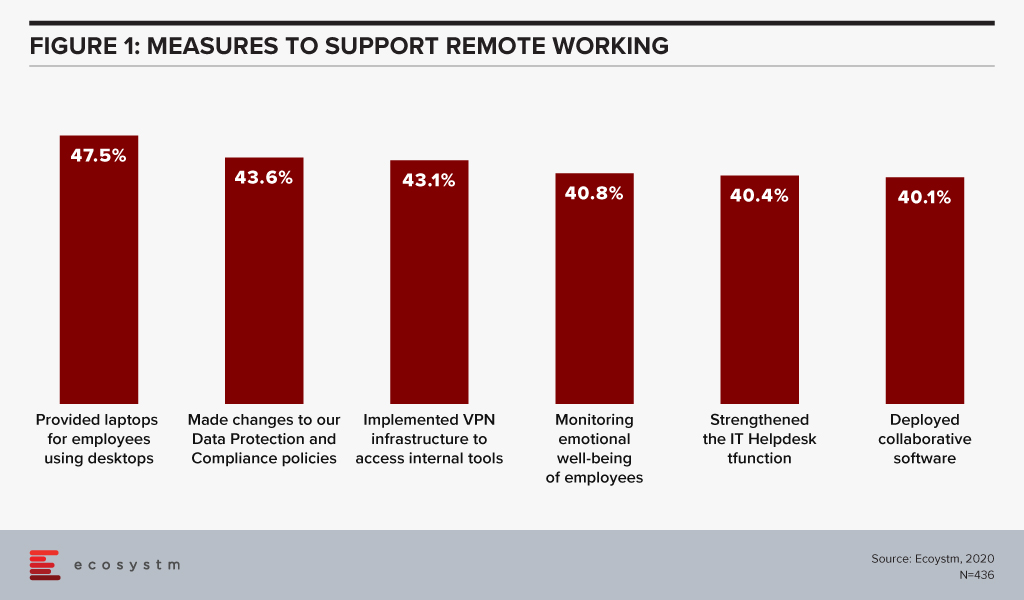
Many countries or economies are now moving to a hybrid working arrangement. This ISN’T about “going back to the way things were”. Hybrid working is really an important step on the road to the Digital Workplace – which enables access to the tools, data and processes that employees need to get their job done regardless of location or device.

Many businesses claim that productivity has improved now that employees are working from home – some have even measured it and can prove it. We have to ensure that the move back to the office doesn’t negatively impact productivity. To drive continued productivity with hybrid working arrangements, consider:
- How will video calls work with employees in the office and at home? If employees in the office are docking their laptops, they immediately lose access to the camera. If they have monitors on their desk, they might not even be able to work with the laptop open. If they are in an open-plan office, the regular video calls might be distracting.
- What is the role of meeting rooms in the hybrid workplace? With social distancing an expectation in many countries today, the role of meeting rooms has changed. They will cater for fewer employees, and there is a growing need for them to be video-enabled.
- How do you manage hybrid meetings – where maybe 3-5 employees are on a single camera? How do you ensure every voice has equal weight – and that the right employees have their fair share of voice on the calls.
- How do you support employees who are moving between locations? You must focus on self-help services and automating as much of your Service Desk capabilities as possible.
- How can IT support social distancing in the office? Many companies are scaling back their hot desk environments to ensure there are fewer shared working environments.
- How will the changing location of employees impact business processes? Many of your processes were designed assuming employees were on site. You then redesigned many of them to assume they were not. Do you need to rethink them again?
- Does the application strategy work for all employees? There has been an increase in employees accessing applications from mobile devices – sometimes that was because it was a better experience, but too often it was because it was the only option. Is it time to rethink access and interfaces to make them relevant for all users?
- How do you keep employees and their data secure? Employees might move between secure and unsecured networks, work and home devices, on-premise and cloud applications. How do you keep them secure, backed up and synchronised – regardless of their device or location?
The move to hybrid working might not be a smooth one. The last thing you want to deliver is a poorer experience at one location versus the other, so you have work ahead in keeping your employees productive and secure – and hopefully, you’ll also move further down the path towards a Digital Workplace that can enable and empower all of your employees.

As organisations stride towards digitalisation, re-evaluate their business continuity plans and define what the Future of Work will look for them, Cloud adoption is expected to surge. In June, there were several announcements that indicate the market is responding to this increased interest.
Cloud Providers Gearing up to Enable Economic Recovery
Global economies are slowly gearing up for a technology-led recovery phase and several organisations are taking advantage of the disruption to start or accelerate their digital transformation plans. Many are looking at this as a good opportunity to replace their legacy systems. Cloud providers are expected to lead from the front when it comes to helping the economy recover.
Government agencies have been immensely impacted by the COVID-19 crisis and will need to shift fast into the recovery mode. Salesforce launched a multi-tenant dedicated Cloud infrastructure for their US Federal, state and local government customers, government contractors, and federally funded research and development centres. Hosted on AWS GovCloud and FedRAMP compliant, it provides customers with a compliant and secure environment to deploy Salesforce’s CRM platform and industry solutions. The launch is expected to empower government agencies with the ability to deliver better services, scale to unprecedented demands and connect to citizens on their channel of choice.
Initiatives such as the UK Crown Commercial Service (CCS) and Google Cloud agreement will also help in the recovery phase. This allows qualified public sector agencies to avail of a discounted price for their Google Cloud deployments. Earlier in the year CCS entered into a price arrangement with Microsoft as well. If Cloud has to be the vehicle for economic recovery, such arrangements will benefit cash-strapped public sector organisations.
The recovery will also require the entire technology ecosystem to engage not only with large enterprises but also small and medium enterprises (SMEs). Alibaba Cloud announced an investment of US$ 283 million to revamp its global partner program. They plan to introduce new partner-customer communication processes to enhance response time and bring more opportunities to independent software vendors (ISVs) managed service providers (MSPs) and system integrators (SIs) as partners.
Europe Emerging as a Cloud Hub
As a fallout of the current political scenario, Europe is pushing for more cloud independence and to become an innovation hub as a vendor-neutral network for cloud computing providers and their customers.
GAIA-X Foundation is a federated data infrastructure project initiated to build a unified system of cloud and data services to be protected by EU Laws – including GDPR, the free flow of non-personal data regulation and the Cybersecurity Act. France and Germany kicked off the GAIA-X cloud project last year and the system is open for participation to national and European initiatives for exchange of data across industries and services such as AI, IoT and data analytics. GAIA-X took another step towards becoming a real option for European organisations with the establishment as a legal entity in June. Various organisations – including Dassault, Orange, Siemens, SAP, Atos, Scaleway and Deutsche Telekom are a part of this non-profit platform, working together on Cloud applications, high-performance computing as well as edge systems. The project is expecting to release a working model by early 2021 and will be further enhanced in phases.
Global Cloud leaders are also focusing on expanding their presence in Europe. In February, Microsoft announced a new data centre in Spain leveraging Telefónica infrastructure. In a similar move, Google Cloud announced its plans to expand in the region in partnership with Telefónica. Telefonica and Google are expected to jointly work on Spain’s digitalisation through edge infrastructure and 5G for consumers and telecom infrastructure.
Cloud Providers Bolstering their Cybersecurity Capabilities
2020 has witnessed a host of cybersecurity threats and data breaches. While Cloud providers have always evolved their cybersecurity capabilities, it has become important for them to become vocal about these measures to build trust in the industry.
To complement the Microsoft Azure IoT security, Microsoft acquired IoT security specialist CyberX, last month. The acquisition will enable greater security for the IoT devices connected to the Microsoft network and will help their customers to gain visibility through a map of devices thus allowing them to gather information on security risks associated with thousands of sensors and connected devices. This will enhance smart grid, smart manufacturing and digital assets and profiles and reduce vulnerabilities across production and supply chain.
In another move which will benefit the ISV and SI ecosystem, NetFoundry’s zero trust networking API is now available on RapidAPI. RapidAPI’s marketplace enables developers to easily find, connect to, and manage the APIs they need to build a range of applications. Now the ISV and developer community can access NetFoundry’s software-only, zero trust models on RapidAPI.
More Partnerships between Software/Industry Solutions Providers and Cloud Providers
The COVID-19 crisis has had a far-reaching impact on several industries. The technologies that are expected to see the most uptake are IoT and Future of Work technologies.
Ecosystm Principal Advisor, Kaushik Ghatak says, “COVID-19 has brought to the fore the need for managing risks better. And the key to managing risks is to have better visibility and drive data-driven decisions; the sweet spot for IoT technologies.”
Last week, Microsoft and Hitachi announced a strategic alliance to accelerate the digital transformation of the Manufacturing and Logistics industries across Southeast Asia, Japan and North America. The first solutions are expected to be made available in Thailand as early as this month. Hitachi brings to the table their industry solutions, such as Lumada, and their IoT-ready industrial controllers HX Series. These solutions will be fully integrated with the Microsoft cloud platform, leveraging Azure, Dynamics 365 and Microsoft 365.
Another sector that has seen significant disruption is Real Estate. Ecosystm Principal Advisor, Andrew Milroy in his blog Proptech: Driving Digital Transformation in the Wake of COVID-19 sees a real opportunity for the sector to transform. “Many activities within the property ecosystem have remained unchanged for decades. There are several opportunities for digital engagement and automation in this sector, ranging from the use of robots in construction to the ‘uberisation’ of the residential property customer journey.”
June saw Honeywell and SAP partner to create a joint cloud-based solution based on Honeywell Forge and SAP cloud. The cloud solution is aimed at real estate operators and customers providing aggregated financial and operational insights in real-time. The solution leverages the Honeywell Forge autonomous buildings solution and the SAP Cloud for Real Estate solution, enabling facility managers and building owners to reposition their real estate portfolios through parameters such as cost savings and energy efficiency and help improve the tenant experience.
As organisations struggle to maintain operations during the ongoing crisis, there has been an exponential increase in employees working from home and relying on the Future of Work technologies. Ecosystm principal Advisor, Audrey William says, “During the COVID-19 pandemic, people have become reliant on voice, video and collaboration tools and even when things go back to normal in the coming months, the blended way of work will be the norm. There has been a surge of video and collaboration technologies. The need to have good communication and collaboration tools whether at home or in the office has become a basic expectation especially when working from home. It has become non-negotiable.”
AWS and Slack announced a multi-year partnership to collaborate on solutions to enable the Workplace of the Future. This will give Slack users the ability to manage their AWS resources within Slack, as well as replace Slack’s voice and video call features with AWS’s Amazon Chime. And AWS will be using Slack for their internal communication and collaboration.
Delivering excellent customer experience in the midst of the crisis has proved to be difficult for organisations. Customer care centres have been especially impacted by high volumes of customer interactions – through voice and non-voice channels. This will see a major rise in adoption of cloud contact centre solutions. Contact centre providers are ramping up their capabilities in anticipation. Genesys selected AWS as their preferred cloud partner to deliver new features to customers and build a global and secure infrastructure.
The industry can expect more news from Cloud providers in the next few months as they ramp up their capabilities and channel their go-to-market messaging.
Gain access to more insights from the Ecosystm Cloud Study



